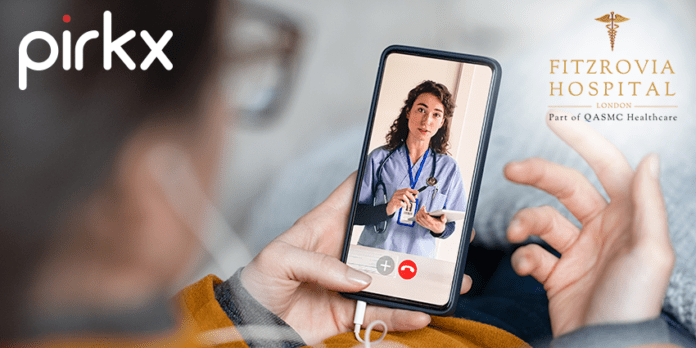As waiting lists grow, how can technology ease the burden on healthcare institutions.
When we talk about healthcare these days it’s usually in the guise of what we can do for ourselves.
But while the politicians play games with the health service, the one constant is that we will all need a doctor one day; no matter how many times you go to the gym Ken!
Yet in a digital age where people are sharing birthday messages over Facetime, we are still relying on a doctor’s surgery to make sure our coughs aren’t an infection.
That may seem archaic and it’s always easier to be the innovator than the practitioner, but we have been talking about this idea for years, as Dr. William Wong, a Consultant General Practitioner at Fitzrovia Medical Clinic explains.
“The idea of eConsults and remote healthcare has indeed been around for quite some time, but the implementation and widespread adoption of these concepts have proven to be quite challenging.
“This is especially true for the National Health Service (NHS) in the UK, which heavily relies on traditional, in-person doctor visits despite the ever-growing waiting lists. However, the potential benefits of eConsulting cannot be ignored, and finding ways to overcome these obstacles is crucial in improving access to healthcare for patients.”
The (e)Doctor will see you now
That access is something that health institutions are facing at the moment. While doctors appear to be unavailable for weeks, Accident and Emergency departments become periodical hubs for all ailments and a breeding ground for opportunistic viruses like the norovirus.
So if the incumbent competition to eConsults is as bad as the media would have us believe, then why haven’t they taken off yet? Wong added that providers need to change tact when convincing patients to adopt the solution.
“eConsulting involves using digital platforms and technologies to connect patients with healthcare professionals remotely. Patients can access these platforms through their smartphones, tablets, or computers, and can communicate with doctors via secure messaging systems or video calls. This allows patients to seek medical advice and receive consultations without having to physically visit a doctor’s office or hospital.
“To convince patients to embrace online consultancy, it is important to highlight the convenience and accessibility it offers. With eConsults, patients can skip the long waiting times and the need to travel to a healthcare facility, making it incredibly convenient, particularly for those with mobility issues or living in remote areas.
“Additionally, eConsults can provide patients with quicker access to medical advice, enabling earlier intervention and potentially preventing more serious health problems down the line.”
Proof of Consulting
As convincing as these arguments are, eConsults still appear to be a theoretical solution at the moment.
However Wong says there have been “several successful examples of eConsulting in practice,” adding “in the United States, the Veterans Health Administration has implemented a telehealth program that allows veterans to access healthcare remotely. This has resulted in improved patient satisfaction, reduced hospitalizations, and significant cost savings.
“Similarly, in Canada, the Ontario Telemedicine Network has successfully integrated eConsults into primary care, resulting in reduced wait times and improved access to specialists for patients in rural and underserved areas.”
Stella Smith, Founder and CEO of pirkx, was also able to give an example of how eConsulting has helped diagnose and treat patients. A case study for the Pirkx solution reads as follows:
My daughter was really poorly, and I was struggling to get an appointment with my GP. On this occasion, she couldn’t swallow, or eat, had a fever of over 39 degrees; lost weight and generally felt unwell.
I was extremely worried. I went online to see if I could get her an appointment with a pirkx doctor. Within 5 minutes I had her booked for a video consultation for a couple of hours later.
The doctor saw her and diagnosed her then and there, giving her much-needed antibiotics and medicine, as well as offering a follow-up appointment.
I would definitely recommend the service to my family and friends. A private GP is between £80 and £150 plus, and then there are extras on top, like if you turn up 10 mins late they keep the money and you have to pay again. pirkx is really good value for money.
Barriers to treatment
One of the more compelling reasons why eConsults make sense is that we already have the technology to carry them out in the palm of our hands.
According to research from USwitch, at the start of last year, there were 71.8 million mobile connections in the UK, 4.2 million more than the UK population, increasing by 3.8% from 2021 or around 2.6 million. On top of this, by 2025, it is predicted that the UK population will reach 68.3 million and that 95%, or roughly 65 million people, will be using a smartphone.
As the population continues to become technology literate, Marzio Ghezzi, CEO at Mia-Care said that enabling doctors, and more widely the healthcare industry, to be able to serve patients virtually.
“Patients are increasingly getting used to connecting with their doctors remotely, so we need to provide healthcare organisations with the tools they need to fulfil the IT requirements of telemedicine.
“In this way patients can benefit in their homes from the many excellent medical devices and applications that are coming to market to help combat our greatest healthcare challenges. The future direction of telemedicine lies in giving healthcare providers a single point of access to multiple devices and data sources in a safe and compliant way, which will result in better quality of care for patients. Near real-time monitoring, tracking and therapy observations will encompass more medical IoT devices for use at home via a modern healthcare platform.
“Dealing with multiple medical devices presents healthcare providers with many challenges, which can often be a barrier to their adoption,” continued Ghezzi. “These include varied device standards, firmware complexity and disparate data, as well as security and privacy concerns.
“To combat this we need to streamline medical device management so that healthcare providers can rely on seamless IoT data collection from trusted devices to treat chronic and acute conditions.”
There are also issues from the consumer side as Wong added: “There are also technological barriers that need to be addressed to facilitate the progress of eConsulting.”
“Firstly, ensuring a reliable and secure internet connection is essential, especially for video consultations. Many remote areas may still lack high-speed internet access, making it challenging for patients in those regions to participate in eConsults.
“Additionally, the digital divide, where some patients may lack the necessary skills or access to technology, needs to be addressed to ensure equitable access to online healthcare services.”
Prescriptions for Change
With the adoption of smartwatches and fitness trackers, Ghezzi said that eConsultations can become a normal part of the healing process, on top of automated systems that improve service.
“There are already many preconfigured accelerators that have been designed to execute the most requested healthcare operations, such as booking appointments, doctor-patient communications and building custom forms for digital patient records.
“This reduces the time needed to design, build and deploy new software applications to manage devices and accelerate digital healthcare transformation. By combining with the right medical IoT cloud infrastructure you can connect multiple devices without the need for individual patient configuration.”
Using Pirkx as an example, Smith said that embracing cloud technology has been key to the success of their solution.
“What we’ve done at pirkx is created a piece of technology – with the help of AWS – where we’ve essentially built an enterprise engine from scratch so that we can get it to as many as possible. It is our technology that allows us to deliver our services so widely and affordably.
“By using our vast data, we can decipher exactly which services will be in demand and when. As a result, this allows pirkx to function much like a gym and offer our wide range of amazing services including remote GP appointments.
“We believe that by utilising technology we will be able to reach our goal of positively impacting one million lives by 2025, by ensuring that affordable and accessible healthcare is available to everyone.”




